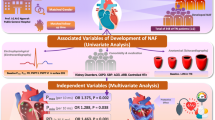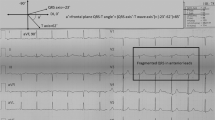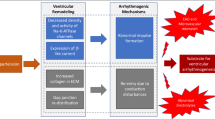Abstract
Increased dispersion of ventricular repolarisation (increased QT dispersion) is believed to predispose to arrhythmias associated with sudden death in certain cardiac diseases. Hypertension is also associated with increased risk of sudden death, particularly in those with left ventricular hypertrophy (LVH). Therefore, the first aim of this study is to look into the possible pathogenic role of QT dispersion on the ventricular arrhythmias occurring in a group of never-treated hypertensive patients. The second aim is to look at other possible determinants of QT dispersion (ie, level of blood pressure, hypokalaemia, electrocardiographic LVH and presence or absence of strain pattern) in hypertensive patients, and their relevance to complex ventricular arrhythmias. QTc (corrected QT) was measured in 70 newly presenting (never-treated) hypertensive patients (47 male, 23 female, mean age 51.9 ± 12.5 years) from a standard 12-lead surface electrocardiogram (ECG). Blood pressure measurements and 24-h ECG holter recordings were performed in all patients. Serum potassium level was measured in 51 of the patients. Ventricular arrhythmias were classified using a modified Lown’s scoring system. Maximum QTc, minimum QTc and QTc dispersion for all patients were 442 ± 30.3 ms, 380 ± 26.7 ms and 61.5 ± 21.6 ms respectively. High grade ventricular arrhythmias (Lown’s score ⩾3) were found in 43% of the patients. The QTc dispersion was strongly correlated with the Lown’s classification of arrhythmia and the age of the patients. Patients with more severe ectopy (Lown’s score ⩾3) were significantly older (57.4 ± 10.3 years) compared to those with score ⩽2 (48.3 ± 12.6 years) (P = 0.0067) and had a significantly greater QTc dispersion (69.9 ± 22.5 ms vs55.2 ± 18.8 ms; P = 0.002). Presence of electrocardiographic strain did not affect the severity of arrhythmia, as 29% of the patients with LVH and strain had grade ⩾3 Lown’s score compared to 39% in the group with LVH but without strain. In the presence of relative hypokalaemia, hypertensive patients with LVH showed more QTc dispersion (85.7 ± 15.5 ms) and a greater tendency for complex ventricular arrhythmias (100% grade ⩾3 Lown’s score) compared to those with LVH and normal serum potassium levels (64.1 ± 22.6 ms and 35%, QTc dispersion and Lown’s score ⩾3, respectively P = 0.05). The level of blood pressure had no effect on either the QTc dispersion or the prevalence of complex ventricular arrhythmias. Prevalence of complex ventricular arrhythmias in hypertensive patients is strongly correlated with QTc dispersion and age. When hypertensive patients with LVH have low potassium levels the risk of developing complex ventricular arrhythmias is significantly increased.
This is a preview of subscription content, access via your institution
Access options
Subscribe to this journal
Receive 12 digital issues and online access to articles
$119.00 per year
only $9.92 per issue
Buy this article
- Purchase on Springer Link
- Instant access to full article PDF
Prices may be subject to local taxes which are calculated during checkout
Similar content being viewed by others
Author information
Authors and Affiliations
Rights and permissions
About this article
Cite this article
Saadeh, A., Evans, S., James, M. et al. QTc dispersion and complex ventricular arrhythmias in untreated newly presenting hypertensive patients. J Hum Hypertens 13, 665–669 (1999). https://doi.org/10.1038/sj.jhh.1000908
Received:
Accepted:
Published:
Issue Date:
DOI: https://doi.org/10.1038/sj.jhh.1000908



